DENVER-2
(Last updated 11/9/00)
The "Modern Gothic" Trinity United Methodist Church
(left), designed and built (1888) by Robert Roeschlab, sits just
north of the upper Mall at 18th and Broadway - its spire is nearly
184 ft high, and its exterior is faced with locally quarried Castle
Rock rhyolite. The view from Broadway down 17th Street (back towards
the CBD; right) includes the mirrored glass facade of the 38-story
QWest Building (1979) and the red granite of the historic and
elegant Henry C. Brown Palace Hotel (1892; at lower right) - which
frequently played the role of summer White House during the Eisenhower
administration.
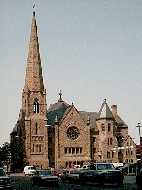
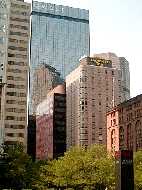 The Voorhies Memorial (1919) is located
a few short blocks in the other direction, at 15th and Colfax;
a colonnade of Turkey Creek sandstone around a reflecting pool
with twin cherub fountains, the Voorhies provides an entrance
to the north end of Civic Center Park; a similar structure, the
open air Greek Theatre, frames the Park's south end.
The Voorhies Memorial (1919) is located
a few short blocks in the other direction, at 15th and Colfax;
a colonnade of Turkey Creek sandstone around a reflecting pool
with twin cherub fountains, the Voorhies provides an entrance
to the north end of Civic Center Park; a similar structure, the
open air Greek Theatre, frames the Park's south end.

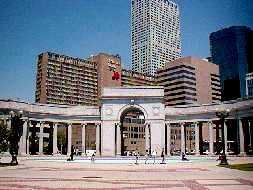 The Park is a three block area ringed
by Federal, state, city, and commercial office buildings, and
the heart of modern Denver. The neoclassical City and County Building
(1924-32) - complete with tower chimes, 3-story high Corinthian
columns of travertine to mark its entryway, and courtrooms which
provided the backdrop for "Perry Mason" - occupies the
Park's west end
The Park is a three block area ringed
by Federal, state, city, and commercial office buildings, and
the heart of modern Denver. The neoclassical City and County Building
(1924-32) - complete with tower chimes, 3-story high Corinthian
columns of travertine to mark its entryway, and courtrooms which
provided the backdrop for "Perry Mason" - occupies the
Park's west end

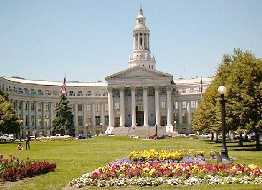 Sculptures everywhere in the Park remind
Denverites of their origins - the Pioneer Monument (left) by Frederick
MacMonnies (1911) is topped by Kit Carson, "The Hunter"
(center) is one of three bronzes that surround the base; the Bronco
Buster (right) is a bronze by Alexander Proctor (1920)
Sculptures everywhere in the Park remind
Denverites of their origins - the Pioneer Monument (left) by Frederick
MacMonnies (1911) is topped by Kit Carson, "The Hunter"
(center) is one of three bronzes that surround the base; the Bronco
Buster (right) is a bronze by Alexander Proctor (1920)


 The Veterans Monument (left), constructed
(1990) of red sandstone from the Boulder area, now occupies the
center of the short Park block between Broadway and Lincoln; looking
east from the VM provides a great view of the State Capitol Building
(right), which anchors the far eastern end of the Park
The Veterans Monument (left), constructed
(1990) of red sandstone from the Boulder area, now occupies the
center of the short Park block between Broadway and Lincoln; looking
east from the VM provides a great view of the State Capitol Building
(right), which anchors the far eastern end of the Park

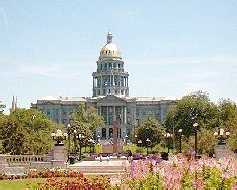 Although the land was obtained in 1867,
the cornerstone for the Capitol (left) was not laid until July
4, 1890; the building itself was constructed using all Colorado
materials - the foundation and walls are Fort Collins sandstone,
granite is from the Gunnison area, and the interior wainscoting
used the world's supply of Colorado rose onyx [also called Beulah
red marble for the small town in the foothills of the Greenhorn
Mountains near where it was discovered (in 1859)]; the 193-ft
high dome (right) was originally clad in copper, but when that
turned a dull green, Denver's citizens decided to cover it with
gold leaf - first in 1908 at a cost of $15,000 (including the
labor!), then again in 1950, 1980, and 1991
Although the land was obtained in 1867,
the cornerstone for the Capitol (left) was not laid until July
4, 1890; the building itself was constructed using all Colorado
materials - the foundation and walls are Fort Collins sandstone,
granite is from the Gunnison area, and the interior wainscoting
used the world's supply of Colorado rose onyx [also called Beulah
red marble for the small town in the foothills of the Greenhorn
Mountains near where it was discovered (in 1859)]; the 193-ft
high dome (right) was originally clad in copper, but when that
turned a dull green, Denver's citizens decided to cover it with
gold leaf - first in 1908 at a cost of $15,000 (including the
labor!), then again in 1950, 1980, and 1991
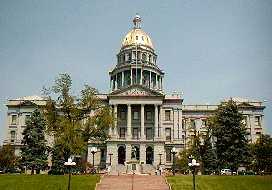
 Continuing east from the Park on Colfax
Avenue, the dividing line between the Capitol Hill and Uptown
neighborhoods, leads to the massive 195 x 116 ft French Gothic
cruciform-shaped Cathedral of the Immaculate Conception (1906-12),
designed by Leon Coquard, with bell spires towering 210 ft above
the street; the Cathedral, which was designated as a basilica
by Pope John Paul II in 1979, contains 75 stained glass windows
made in Munich, including a large rose window (right) over the
choir loft at the rear.
Continuing east from the Park on Colfax
Avenue, the dividing line between the Capitol Hill and Uptown
neighborhoods, leads to the massive 195 x 116 ft French Gothic
cruciform-shaped Cathedral of the Immaculate Conception (1906-12),
designed by Leon Coquard, with bell spires towering 210 ft above
the street; the Cathedral, which was designated as a basilica
by Pope John Paul II in 1979, contains 75 stained glass windows
made in Munich, including a large rose window (right) over the
choir loft at the rear.
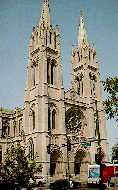

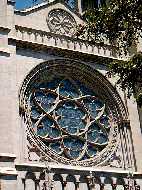 Two blocks away at 16th Avenue and
Pearl, Congregation Emanuel, founded in 1874, built (1898) a new
Byzantine and Moorish style synagogue (designed by John Humphrey;
left) with two copper-topped minarets when its old temple was
destroyed by fire - a third tower (on the left) was added in 1924,
doubling its size; when the congregation moved again in 1956 the
building, one of Denver's most unique structures and an Historic
Landmark, was converted into the Uptown Temple Events Center Meeting
Facility; further east, Colfax Avenue continues its resurgence
as a retail area (right)
Two blocks away at 16th Avenue and
Pearl, Congregation Emanuel, founded in 1874, built (1898) a new
Byzantine and Moorish style synagogue (designed by John Humphrey;
left) with two copper-topped minarets when its old temple was
destroyed by fire - a third tower (on the left) was added in 1924,
doubling its size; when the congregation moved again in 1956 the
building, one of Denver's most unique structures and an Historic
Landmark, was converted into the Uptown Temple Events Center Meeting
Facility; further east, Colfax Avenue continues its resurgence
as a retail area (right)
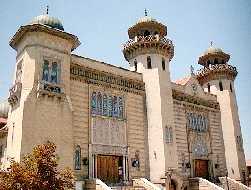
 Lincoln and Colfax marks the northwest
corner of the Capitol Hill neighborhood, founded in the 1880s
as a new suburb for the wealthiest of Denver's families - who
built extravagant Victorian, Tudor, and Greek Revival mansions
of sandstone and granite. The neighborhood is one of Denver's
most historic and diverse, containing buildings like the Margaret
Tobin (unsinkable Molly) Brown House (1890; left) at 14th and
Pennsylvania; further east on 14th, a castle-like Romanesque Victorian
residence complete with turret and tower (center) and a Greek
Revival neighborhood church (right)
Lincoln and Colfax marks the northwest
corner of the Capitol Hill neighborhood, founded in the 1880s
as a new suburb for the wealthiest of Denver's families - who
built extravagant Victorian, Tudor, and Greek Revival mansions
of sandstone and granite. The neighborhood is one of Denver's
most historic and diverse, containing buildings like the Margaret
Tobin (unsinkable Molly) Brown House (1890; left) at 14th and
Pennsylvania; further east on 14th, a castle-like Romanesque Victorian
residence complete with turret and tower (center) and a Greek
Revival neighborhood church (right)
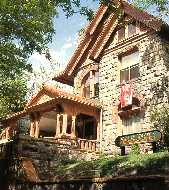

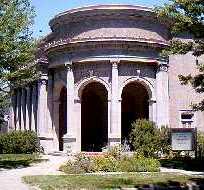 More modest homes occupy the Wyman
Addition, an Historic District to the east
More modest homes occupy the Wyman
Addition, an Historic District to the east

 Cheesman Park (left), once the city
cemetery and now surrounded by modern high rises, marks the eastern
end of the neighborhood; a watercolor artist (right) takes advantage
of a little park shade on a very hot afternoon
Cheesman Park (left), once the city
cemetery and now surrounded by modern high rises, marks the eastern
end of the neighborhood; a watercolor artist (right) takes advantage
of a little park shade on a very hot afternoon

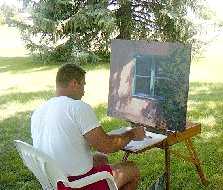 A Greek Parthenon-style Memorial, built
(1910) of Colorado Yule marble (left), crowns the east end of
the Park and is dedicated to Walter S. Cheesman, who helped found
the Denver Pacific Railroad and later became president of the
Denver Union Water Company; the 13,000 square-foot Boettcher Memorial
Conservatory (right), originally built in the 1960s, is a centerpiece
of the adjacent 23-acre Denver Botanical Garden, which also occupies
what was once cemetery grounds
A Greek Parthenon-style Memorial, built
(1910) of Colorado Yule marble (left), crowns the east end of
the Park and is dedicated to Walter S. Cheesman, who helped found
the Denver Pacific Railroad and later became president of the
Denver Union Water Company; the 13,000 square-foot Boettcher Memorial
Conservatory (right), originally built in the 1960s, is a centerpiece
of the adjacent 23-acre Denver Botanical Garden, which also occupies
what was once cemetery grounds
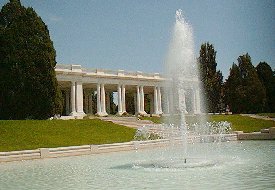
 Go to Denver-1 | Return
to Home Page
Go to Denver-1 | Return
to Home Page


























